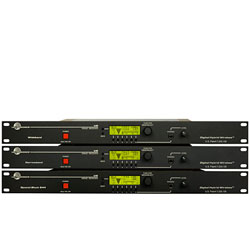|
ASC (Canada) Ltd. Phone: 416-251-5409 Sales Rentals Service Carts & Custom Work Specials Consignment Used Goods Downloads Links Contact Us |
|
Venue Modular Receiver System
The receiver modules are easy to change with no tools required. The wideband multicoupler allows the use of any frequency module in any position, except when modules are paired, they must be in adjacent positions as marked on the panel. A major benefit of the design is the inclusion of a high quality antenna multicoupler. The multicoupler is actually a 1 in, 7 out splitter with six outputs for the receiver modules and an additional output as a "loop thru" for another Venue receiver. This allows multiple Venue receivers to operate from a single pair of antennas. Phantom power for remote antenna amplifiers is available from the multicoupler antenna inputs using internal jumpers.

Individual screens for each receiver are also available at the touch of a button to provide additional information and setup adjustments. A headphone jack and level control is provided for individual channel monitoring.

Two modules are available to further customize the configuration for specific applications. The VRS standard module has fixed front-end filters that cover its 25.5 MHz tuning range. The higher selectivity VRT module has tracking front-end filters that retune as the frequency is changed to stay centered over the selected frequency. The modules are a triple conversion, frequency synthesized design, controlled by the microprocessor in the host assembly. A common DSP in the host assembly is used for all six receiver modules to decode the received signals and restore the digital audio. Using a single DSP results in a significant reduction in cost per channel. The host assembly will handle up to six receiver modules via multi-pin connectors on the side of the main housing. The modules are held in place with snap-in retaining clips. The clips hold the modules firmly but are easy to remove without tools to make needed changes. Every Venue receiver has a built-in multicoupler that utilizes high current RF amplifiers and a Wilkinson type splitter for even signal distribution and high isolation between receiver modules. Optimally matched levels allow multiple receivers to be stacked and share a single pair of antennas - a significant savings in space and cost in multi-channel systems. An automated scanning process is also available that tunes a receiver module across its tuning range and selects a frequency with the least RF energy. The process takes less than 30 seconds and the screen prompts the operator to turn on a transmitter for the last frequency selected before continuing. Once the transmitter is turned on, the process continues, prompting the operator to continue and select the next receiver to tune. As the receiver is tuned to each frequency, the analysis evaluates RF energy within the channel as well as energy above and below the channel to avoid selecting a frequency adjacent to a high powered signal. Digital Hybrid Wireless® is a revolutionary new design that combines digital audio with an analog FM radio link to provide outstanding audio quality and the exemplary RF performance of the finest analog wireless systems. This overcomes channel noise in a dramatically new way, digitally encoding the audio in the transmitter and decoding it in the receiver, yet still sending the encoded information via an analog FM wireless link. This proprietary algorithm is not a digital implementation of an analog compandor. Instead, it is a technique which can be accomplished only in the digital domain. The process eliminates compandor artifacts, expanding the applications to include test and measurement of acoustic spaces and musical instruments. Block 470 470.100 - 495.600 Block 19 486.400 - 511.900 Block 20 512.000 - 537.500 Block 21 537.600 - 563.100 Block 22 563.200 - 588.700 Block 23 588.800 - 607.900 and 614.100 - 614.300 Block 24 614.400 - 639.900 Block 25 640.000 - 665.500 Block 26 665.600 - 691.100 Block 944 (VRS only) 944.100 - 951.900 Frequency selection: 256 frequencies in 100 kHz steps per 25.5 MHz frequency block Channel Spacing: 100 kHz Dual Block Range: Built in antenna mulitcoupler covers a two block range. Pilot tone: 25 to 32 kHz; 5kHz deviation; unique pilot tone frequency for each selected carrier frequency (Hybrid mode) Deviation: ± 75 kHz (max) (Hybrid mode) Receiver Type: Triple conversion superheterodyne Frequency Stability: ±0.001 % Multicoupler Bandwidth: Wideband High: 665 - 862 MHz, Wideband Mid: 537 - 768 MHz, Wideband Low: 470 - 691 MHz, Special Block 944: 8 MHz; 944 - 952 MHz Front End Bandwidth: VRS Module: 30 MHz @ -3 dB, VRT Module: 11 MHz @ -3 dB Sensitivity (20 dB Sinad): 0.9 uV AM Rejection: >60 dB, 2 µV to 1 Volt Image and Spurious Rejection: 85 dB Third Order Intercept: VRS:+0 dBm, VRT: +6 dBm Diversity Methods: Switched, ratio and frequency FM Detector: Digital pulse counting detector @ 300 kHz Frequency Response: 32 Hz to 20 kHz (±1dB), overall system (400 Series mode) THD: 0.2% (typical) (400 Series mode) Input Dynamic Range: 125 dB (with full transmitter limiting) Audio Output Level: -15 dBu to +8 dBu, in 1 dB increments LCD: 122x32 graphical display Power Requirements: 10 to 18 VDC; 17.2 W max. (1.72 A @ 10 VDC to 1.05 A @ 18 VDC) Weight: VRM with 6 VRS modules: 4.28 lbs. (1946 g) VRM with 6 VRT modules: 4.45 lbs. (2018 g) Dimensions: 19"W x 1.75"H x 7.75"D (panel to rear jacks) (48.26 cm x 4.45 cm x 19.67 cm) Specifications subject to change without notice. |
